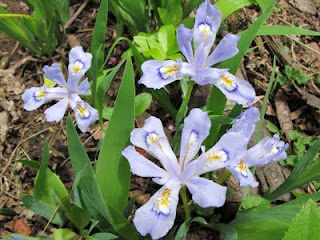 |
| Iris tectorum alba, Pries photo |
Iris tectorum (the Japanese roof Iris) is one of the easiest species to grow. Many years ago, I heard about a variegated form and got very excited. In my eyes, the white flowers of Iris tectorum are one of the most enchanting of Iris flowers. Unfortunately, this variegated form was said to have blue flowers. I imagined how stunning the white flowers could be with beautiful variegated foliage.
When I finally saw some plants of this variegated form, I was
somewhat disappointed in the quality of the variegation. It was much like some
of the variegated, tall-bearded irises that have irregular streaks and stripes.
It was, though, much more pronounced than what you see in virus-infected plants. However, the plants themselves were not robust growers, and this clone seems to have
died out in cultivation.
There was one troubling fact. The insert image of the blue flowers was not Iris tectorum. At the time, I lived in zone 6 in Missouri. The image I thought looked very much like images I had seen of Iris japonica. But japonica does not tolerate zone 5 winters well. The foliage when received appeared more glossy.
 |
| Iris japonica flowers, Hensler photo |
 |
| Variegated Iris japonica Pries photo |
In trying to find out more about variegated Iris japonica, I found
references that suggested there is more than one form of variegation and at
least two types grow in Japan.
The next year I visited a very large perennial nursery outside of St. Louis. The proprietor—who I knew well—was proud to show me a huge planting of variegated Iris tectorum being used as a groundcover. It was absolutely gorgeous. I felt a bit guilty when I told him it was not Iris tectorum but japonica. I warned him it would not make it through the winter but he did not dig it up and it all perished. More and more I kept seeing Iris japonica incorrectly labeled as Iris tectorum in the trade.
 |
| Iris japonica, one of three focal points. The others are Brugmansia 'Snowdrift' upper right and variegated Curcuma; Pries photo |
Since moving to North Carolina (zone 7) I have grown many forms of Iris japonica. Tony Avent’s Plant Delights Nursery (zone 8) has selected several with differing flower colors. All the green leaf forms survive my winters. They are especially good as groundcovers under the dry shade of Pine trees. But I still love the variegated form which I maintain as a pot plant. It seems just a bit more tender than its green cousin. It is especially attractive as a focal point in my houseplant garden and is a feature of my deck garden of potted plants. I would be delighted to find other forms of the japonica but someday I hope to grow a true variegated tectorum.
 |
| Variegated Iris japonica repeats the angular texture of Yucca 'Colorguard' Pries photo |














































